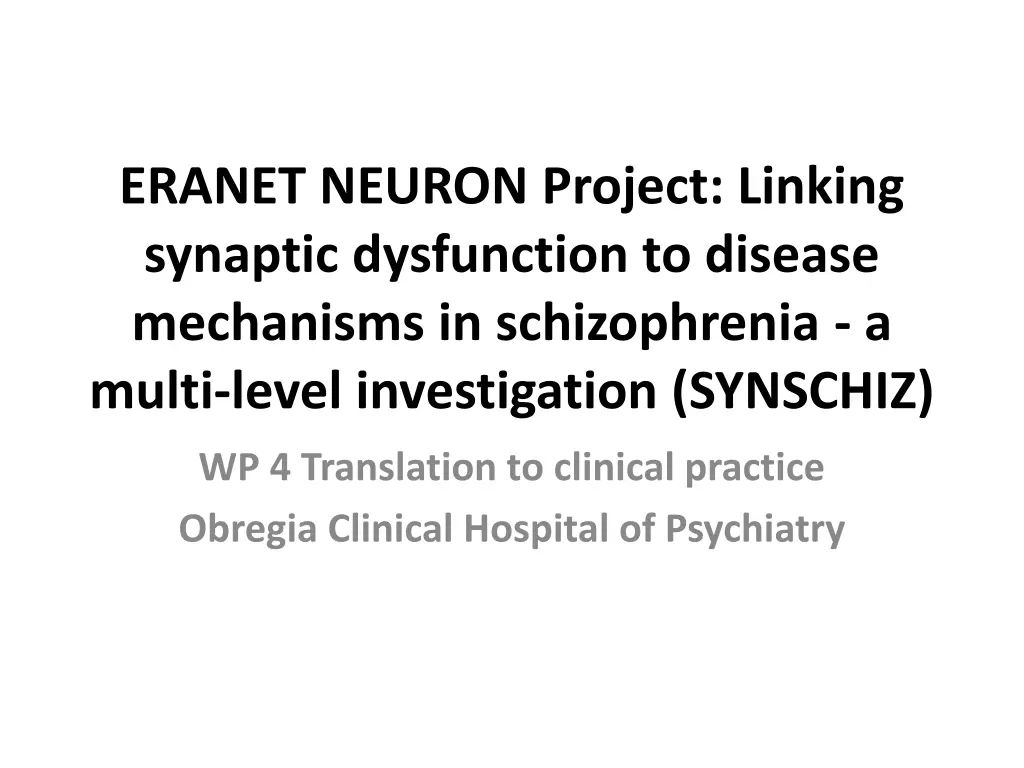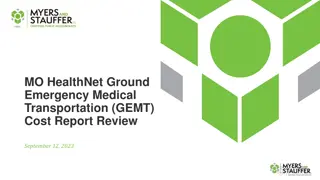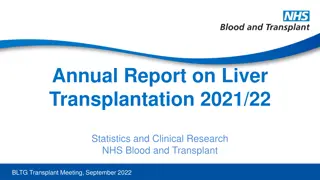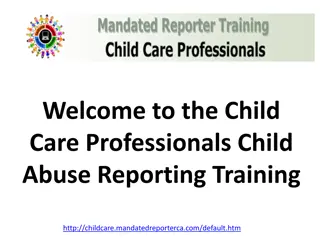
Investigating Synaptic Dysfunction in Schizophrenia at Obregia Clinical Hospital
Explore how the ERANET.NEURON project is linking synaptic dysfunction to disease mechanisms in schizophrenia through a multi-level investigation at Obregia Clinical Hospital. Learn about the translation of research findings to clinical practice, including the clinical evaluation of patients and initial results from the study.
Download Presentation

Please find below an Image/Link to download the presentation.
The content on the website is provided AS IS for your information and personal use only. It may not be sold, licensed, or shared on other websites without obtaining consent from the author. If you encounter any issues during the download, it is possible that the publisher has removed the file from their server.
You are allowed to download the files provided on this website for personal or commercial use, subject to the condition that they are used lawfully. All files are the property of their respective owners.
The content on the website is provided AS IS for your information and personal use only. It may not be sold, licensed, or shared on other websites without obtaining consent from the author.
E N D
Presentation Transcript
ERANET NEURON Project: Linking synaptic dysfunction to disease mechanisms in schizophrenia - a multi-level investigation (SYNSCHIZ) WP 4 Translation to clinical practice Obregia Clinical Hospital of Psychiatry
OBJECTIVE The objective of the first phase of the project was the initiation of the patients group. Start data 01.05.2018
METHODS A. Elaboration of the documents for obtaining the approval from Ethics Committee of the Clinical Hospital Of Psychiatry "Prof. Dr. Alex. Obregia". Specific documents, which included informed consent for the patient or his / her legal representative and a description of the project, were submitted to the Ethics Commission of the Clinical Psychiatric Hospital "Prof. Dr. Alex. Obregia ". The Ethics Commission approved the project activities.
METHODS B. Methodology for clinical evaluation of patients with schizophrenia A working protocol was developed for constitution of the patient group.
Visit 1 Inclusion criteria: diagnosis of schizophrenia including all subtypes according to DSM IV and ICD 10. Exclusion criteria: psychoactive substance use that can induce psychosis. The patient / legal representative is informed about the present study. The patient / legal representative signs the Informed Consent in 2 copies in the presence of the doctor and keeps a copy. Patient code Sex Date of birth Ethnicity Clinical and psychiatric evaluation Diagnosis: Schizophrenia with all the subtypes according to DSM IV TR and ICD 10 Patient history Family history Personal medical history comorbidities (medical documents to prove) with associated medication Psychiatric history - data on the age at onset, number of episodes, the degree of remission of inter- episodes symptomatology, the previous neuroleptic treatment, the mentioning of possible suicide attempts Scales: PANSS, Calgary Scale, Sheehan Disability Scale (SDS), Addenbrooke s Cognitive Examination Blood taking for: Complete blood count; Hormones: TSH, fT4, prolactin; Inflammation markers: ESR, CRP; Biochemistry: TGP, TGP, GGT, LDL-cholesterol, HDL-cholesterol, triglycerides, total lipids, glycaemia, HbA1c; Ionogram: Na, K, Cl Blood for DNA extraction Setting up a schedule for EEG, MRI
RESULTS In the current stage, 230 patients with schizophrenia were clinically evaluated: 221 - adult patients with paranoid schizophrenia 9 - adolescents with schizophrenia or acute psychosis.
The anamnesis included: - history of the disease: onset of symptoms, evolution, trigger factors; - family history: the existence of other relatives with schizophrenia or other mental illness in the patient's family; - personal history: school and professional route, drugs consumption, association of other medical conditions.
49 patients donated blood for genetic studies 43 adults 6 adolescents
Adult patients 30 females 13 males females males
Adult patients Age distribution: 21 69 yrs. 20-29 yr 30-39 40-49 50-59 60-69
Adult patients Familial history positive for psychiatric diseases 13 patients 13 positive negative 30
Adult patients cardiovascular diseases osteoarticular diseases metabolic diseases Comorbidities 20 patients 1 1 1 7 2 hypotiroidism 2 3 tumors unilateral hypoacusis epilepsy
Adult patients 35 Marital status: 5 patients married 5 patients divorced 1 patient widow 31 patients no partner 30 25 maried 20 divorced 15 no partner 10 widow 5 0 males females
Adult patients high school faculty Education 30 high school 5 - faculty 3 10 yrs school 2 primary school 2 secondary school 10 cls primary school secondary school
Adolescent patients 5 females 1 male Age 14 17 yrs.: 1 14 yrs. 2 15 yrs. 2 16 yrs. 1 17 yrs.
Adolescent patients Familial history positive for psychiatric diseases 3 patients Personal history 1 patient premature birth with mild delayed psychomotor development 5 patients high school students with good results 1 patient abandoned the school
Schizophrenia in children and adolescents The study included children and adolescents with schizophrenia or acute psychosis admitted to the Child and Adolescent Psychiatry Clinic from January 2017 to May 2019
116 patients aged from 11 to 17 years 74 males and 42 females
62 of adolescents had at least one first-degree or second-degree relative with psychiatric history.
Comorbidities: - epileptic seizures in 8 children, - ADHD in 6 children, - 16 patients associated intellectual disability, mostly the mild form (12 patients).
The disorders onset was due to the use of drugs in 10 patients. In most cases (81 patients), the primary symptoms were hallucinations or delusions; other symptoms included social withdrawal, depressive disposition, aggressivity, and negativism.





















